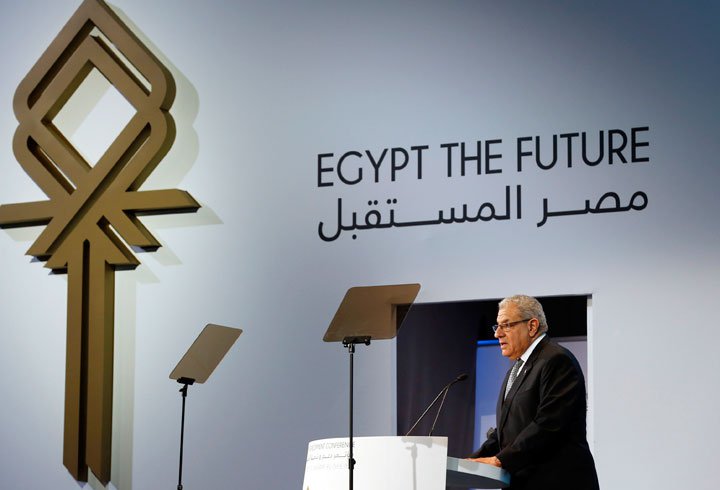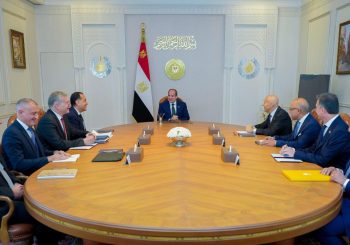
By Ayman Ismail, Assistant Professor and Jameel Chair of Entrepreneurship at The American University in Cairo
The final day of the Egyptian Economic Development Conference (EEDC) was mostly about negotiating and signing many contracts, counting the Dollars, and celebrating success.
While the Suez Canal Zone (SCZ) started the day with four workshops to explain the different future investment opportunities to investors, the real action was taking place behind the scenes in intense negotiations to conclude other deals. The SCZ projects were not ready for this conferences yet, so they’re likely to be offered at a later stage (and hopefully attracting additional large investments, especially from China and the UAE).
The rest of the day had a number of other panels on economic and social inclusion, technology and innovation, financing emerging markets, youth and sports. There were also five sectoral sessions on power, retail and internal trade, agriculture, transport and logistics, and entrepreneurship. In the entrepreneurship session, the World Bank announced $300 million to the Social Fund for Development (SFD) earmarked to small loans for youth-led small and micro enterprises.
Before going to the celebratory part, what exactly did this conference accomplish? Here are the facts:
- A new vision and sectoral strategies for Egypt 2030 launched.
- A new administrative capital announced.
- Urban development plan announced including mega growth plans in north coast (Alamin), Suez Canal Zone, Sinai, Upper Egypt, golden triangle (area connecting Quena, Qusair, and Safaga), and Aswan/Toshka.
- Strong international political support; 15 heads of state and many other senior delegations attending.
- More than 70 CEOs and senior executives from large multinationals attending.
- Heads of all international financial institutions attending. Positive message from Christine Laggard of the IMF.
- $72.5 Billion in investments, facilities and loans. According to the PM’s closing statement, they are divided into $36.2 in signed investment contracts, $18.6B vendor financed infrastructure projects mostly in energy, $5.2 loans from international funds and banks, $12.5B investments/aid package from the four GCC countries. There were higher numbers that were announced, but these mostly relate to MoU’s that may take some time to materialize into solid contracts.
Is this a success?
First, the objectives of the conference were initially to provide a GCC Marshall plan for Egypt; and later, they were expanded to focus on attracting investors rather than just aid. Both objectives were accomplished.
Personally, my expectations prior to the conference were a GCC investment/aid package of around $10-12B, along with $10-15B in private investments. The latter far exceeded the most bullish expectations.
Just to put these figures in perspective: the largest amount of foreign direct investments that Egypt has ever received was $11.6B in 2007, while Egypt’s current foreign currency reserves are around $15B (was $35 in 2009). Egypt’s total foreign debt is around $50B (was around $35B in 2009). So these figures are substantial by all measures.
These figures ($72.5B) do not include the SCZ projects, the new capital, or domestic investments (which is expected to grow as well). This is consistent with Sisi’s comment that Egypt needs $200-300B over the next 3-5 years to reach its ambitious developmental goals.
If the above funds flow fast enough, and the economy is able to absorb them, it is likely that the GDP growth will surge beyond the current target of 6% per year. So from a financial/economic perspective, the conference has far exceeded anyone’s expectations, including the organizers.
Beyond the financial objectives, the conference also had political outcomes. It created a strong positive momentum behind Sisi, both internationally and domestically. Internationally, the high profile presence signals that the post July 3rd period of lack of international recognition is over, and Egypt and its President are now internationally accepted (if not celebrated by many). On the domestic side, the public euphoria is substantial. People watched the conference sessions on TV as if it were a football game. Beyond cementing his position among his core supporters, Sisi started attracting a broader segment of skeptics, especially among youth.
On the personal side, the conference is a major milestone for Sisi. In a way, this is his end of year one score card: he stabilized the country, (almost) restored security, and launched the economic recovery plan and is attracting the investments to fund it. He is also perceived as a strong world leader who is comfortable among his peers. This conference cemented Sisi’s image as a regional leader you can do business with.
To put this in perspective: in 1980, when Mubarak assumed power after Sadat, he held an economic conference which was a great failure. How are the two events different? Mubarak’s conference was organized to ask economists which economic policy (ideology) is better. It was a clueless president trying to find his economic bearing. We all know that if we put two economists in the room, they come up with three onions. Mubarak invited scores of economists who are ideologically diverse, and it ended with them not reaching any conclusions.
Afterwards, for thirty years, Mubarak’s economic policy was “if it’s working don’t fix it!”, which led to great stagnation. In this conference, the government had a clear vision, ideology, and plan, and they were all aligned behind it. It was about mobilizing resources and funds behind this vision. Whether one agrees with that vision or not, that’s a different story. This is why a big part of the criticism for the conference is coming from the left, not only from the pro-Muslim Brotherhood.
The role of the UAE in mobilizing international business support behind this conference is far beyond what is public. They have pulled their full weight and relationships to provide a “Dubai-style” image for the event, and it worked. It is important that this role continues.
Now, for some personal reflections – beyond the celebratory notes.
I have worked a lot on “turnaround” cases for large underperforming corporations, and what I’m observing in Egypt now is classic textbook case. You start by cementing your control and installing your management team; then creating and celebrating some short term “quick wins” to show that things are changing; then changing the mood to a positive forward looking one; then launching a long term vision and plans; then communicating it very loudly and staying on message; then creating a follow-up office that is outside the bureaucracy (PMO) while trying to change the culture and reform the organization over the medium term. These steps typically take 1-2 years to steer a big ship into a different direction. This is exactly what is taking place in Egypt now, and it is moving well on schedule.
The approach to negotiating, signing and follow-up mechanism on the deals signed in this conference shows Sisi’s approach to governance in the next period. They are quickly coming to the realization that the current government bureaucracy is not capable of moving fast enough to realize their plans, so they will opt for creating small parallel structures to bypass the bureaucracy. These are likely to be small technical offices working directly with the ministers to advice, oversee execution and grease the wheels. I personally believe that this is the only solution to move forward in the immediate term, but there is no substitute for administrative reforms over the medium term.
The result of this approach is bypassing proper governance mechanisms to ensure effectiveness. Sisi is acting on strategic decisions like the new administrative capital and the SCZ without parliamentary consultations. The ministers are signing large international agreements. They are launching a new economic and urban development plan without broad public consultations. Nothing illegal about this, but it will be heavily criticized in the coming days. However, this will be the only way to create positive momentum and Sisi is acting with broad public support. The current government has done extensive consultations during the preparations of the economic plan; but, they were not public, instead mostly among experts and business community. It is easy to be critical to this approach (this is not the first time we do this in the Egyptian government), but from a pragmatic perspective, I do not really know of any other way to move forward.
The loud media trumpeting the great success of the conference is raising expectations of fast impact on people’s day to day lives. This is very risky, and not unlike the February 11 2011 euphoria. People need to feel the “conference dividends” in their lives very quickly, and that is a big burden on the government to deliver.
Listening to Mahlab’s closing remarks, there is an emerging posture that “the train is leaving the station and we are moving ahead; join, or you will be left behind.” This is a clear political message both internal and external to reluctant Egyptian businessmen, international business and donor organizations, some countries, as well as local political movements. The government emerging out of this conference is likely to be more assertive and aggressive in moving forward with its agenda with a high sense of urgency.
Personally, I felt a big deal of personal pride and hope during the conference, especially during the closing ceremonies. I’m very conscious that a three day event, however amazing it may have been, will not solve all the political, social and economic woes that were created over decades. However, that should not prevent us from celebrating a good achievement. We need to give ourselves a pat on the back and enjoy a good moment of optimism, without suspending our ability to think critically and voice legitimate concerns.
Heading back to the realities of Cairo, I remain optimistic. The big ship is slowly turning around.







Comments (3)
Excellent article that clearly outlined the goals and achievements of the conference.
Great work. Thanks Ayman.